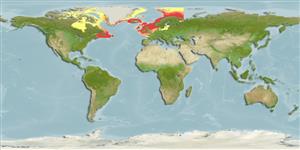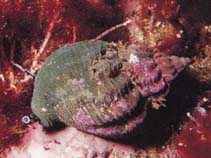Buccinum undatum Linnaeus, 1758
Waved whelk| Native range | All suitable habitat | Point map | Year 2050 |

|
| This map was computer-generated and has not yet been reviewed. |
| Buccinum undatum AquaMaps Data sources: GBIF OBIS |
Классификация / Names народные названия | синонимы | CoL | ITIS | WoRMS
Gastropoda | Neogastropoda | Buccinidae
Environment: milieu / climate zone / пределы глубины / distribution range экология
; пределы глубины 0 - 600 m (ссылка 78657). Temperate, preferred 11°C (ссылка 107945); 85°N - 36°N, 110°W - 45°E
Distribution страны | регионы FAO | Ecosystems | места находок | интродукции
Arctic, Northern Atlantic and the Mediterranean: Canadian Arctic Archipelago and the Atlantic Ocean. Temperate to polar climates.
Length at first maturity / Size / Weight / Возраст
половая зрелость: Lm ?, range 5 - 7.2 cm Max length : 10.2 cm SHL самец/пол неопределен; (ссылка 360); common length : 5.1 cm SHL самец/пол неопределен; (ссылка 360)
Краткое описание морфология
Life cycle and mating behavior половая зрелость | размножение | нерест | Eggs | Fecundity | Larvae
Основная ссылка
ссылки | координатор | соавторы
Harms, J. 1993 Check list of species (algae, invertebrates and vertebrates) found in the vicinity of the island of Helgoland (North Sea, German Bight) - a review of recent records. Helgoländer Meeresunters 47:1-34. (ссылка 2711)
Статус Красного Списка МСОП
(ссылка 130435: Version 2025-1)
Статус СИТЕС (ссылка 108899)
CMS (ссылка 116361)
Угроза для людей
Использование человеком
рыболовство: коммерческий
FAO - рыболовство: landings, Видовой профиль | FishSource | Sea Around Us
инструменты
дополнительная информация
ресурсы в Интернет
BHL | BOLD Systems | CISTI | DiscoverLife | FAO(рыболовство: Видовой профиль; publication : search) | Fishipedia | GenBank (Геном, Нуклеотид) | GloBI | Gomexsi | Google Books | Google Scholar | Google | PubMed | Tree of Life | Wikipedia (Вперёд, поиск) | Zoological Record



